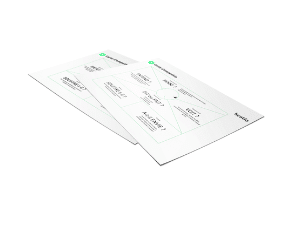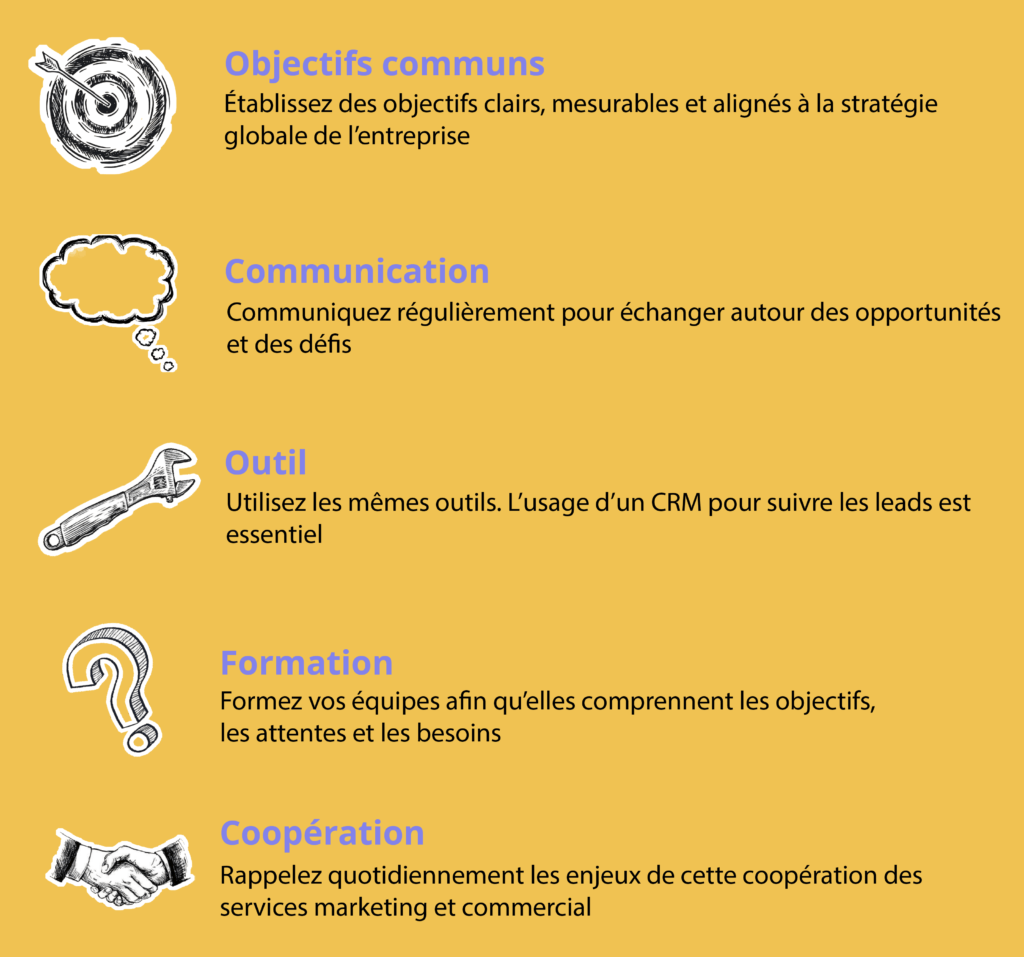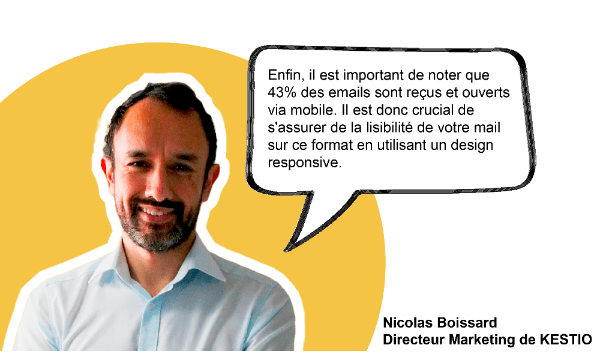Ce chiffre traduit une évolution des pratiques marketing et notamment une surabondance des e-mails reçus (constat que vous partagez sûrement !).
Mais l’e-mail reste l’un des outils de communication les plus efficaces pour une entreprise, permettant de rentrer en contact facilement et à moindre coup avec ses prospects.
Comment alors tirer son épingle du jeu ?
Nous vous livrons aujourd’hui 4 clés à prendre en compte pour assurer le succès de vos campagnes e-mailing !
*Source : Le monde du mail, 2022
CLÉ N°1 - Soyez plus intéressant qu’intéressé
Lorsque vous envoyez un message (e-mail, sms, lettre manuscrite…) à vos proches, vous prenez en considération le destinataire pour en adapter le contenu ?
Dans le cadre professionnel, c’est la même chose !
Le principal écueil en rédaction d’e-mail commercial est de contacter tous vos prospects de la même manière en parlant d’une seule et unique chose : vous-même.
L’objectif de votre prise de contact doit être de répondre à un enjeu rencontré par votre prospect, non pas de lui vendre directement votre offre.
Avant chaque rédaction d’e-mail, nous vous conseillons donc de vous recentrer sur votre cible et votre persona :
- Quel est son profil ?
- Quelles sont ses attentes ?
- Quelles sont ses habitudes de communication et de consommation ?
La carte d'empathie
Pour vous aider à décrypter votre cible, aidez-vous de la carte d’empathie !
En complément du persona, la carte d’empathie est un outil visuel permettant de vous mettre à la place de votre cible afin de mieux comprendre ses émotions et besoins.

|
Grâce à cette définition précise des comportements et besoins de votre cible, vous identifierez plus facilement comment votre offre peut aider son quotidien.
Cela constituera ainsi la thématique de votre e-mail commercial !
En apportant une solution à une problématique vécue par votre prospect, vous attirerez ainsi son attention et optimiserez les chances qu’il souhaite collaborer avec vous.
CLÉ N°2 - Travaillez le copywriting
Le copywriting est l‘art d’écrire du contenu persuasif pour attirer l’attention de votre audience et la convaincre d’effectuer une action spécifique. Un bon copywriting est donc essentiel pour maximiser l’impact de vos campagnes d’e-mails marketing et pour renforcer l’engagement de votre audience.
Structurez votre message
Comme vu ci-dessus, il est important de comprendre qui est votre cible. Vous devez savoir ce qui la motive, ses besoins, ses points de douleur et ses aspirations. Ensuite, il est recommandé de choisir un thème conducteur ou fil rouge par e-mail qui répondra à un point de douleur ou besoin de votre cible. Cela facilitera la lecture et la compréhension de votre message.
La structure du message doit être claire et concise : titres, sous-titres et « bullet points » sont des éléments qui peuvent aider à améliorer la lisibilité et à guider le lecteur à travers le message.
Appliquez la méthode AIDA
La méthode AIDA est la méthode de copywriting la plus utilisée pour convertir un prospect en client. Elle est constituée de 4 étapes distinctes qui guident le lecteur à travers le processus de conversion: l’Attention, l’Intérêt, le Désir et l’Action.
- Pour attirer l’attention du lecteur, utilisez des éléments impactants tels que le design, le titre ou une phrase d’accroche percutante.
- Une fois que vous avez capté l’attention du lecteur, suscitez son intérêt envers votre solution en présentant clairement les avantages qu’elle offre.
- Stimulez le lecteur à désirer votre solution en montrant comment elle peut résoudre ses problèmes et pourquoi elle est la meilleure option.
- Enfin, incitez le prospect à passer à l’action en lui proposant d’acheter votre produit ou service, ou de s’inscrire à votre newsletter pour recevoir plus d’informations utiles.
Utilisez le storytelling
Le choix des mots et les émotions qui en découlent jouent aussi un puissant levier de persuasion. Racontez une histoire pour embarquer votre cible, en utilisant des mots qui évoquent des émotions (positives ou négatives). Vous pourrez créer une connexion émotionnelle avec votre public.
Pensez à l'objet et au pré-header
L’objet de l’email est également crucial pour assurer une ouverture maximale, il est la première chose que les destinataires voient lorsqu’ils reçoivent votre e-mail marketing. Il doit être clair, impactant, spécifique et court. L’objet de l’e-mail doit donner une idée précise du contenu de l’e-mail et inciter les destinataires à l’ouvrir. Évitez les sujets vagues ou génériques, et soyez aussi spécifique que possible.
Par exemple, au lieu d’utiliser “Mise à jour de notre entreprise”, utilisez “5 nouvelles fonctionnalités pour améliorer votre expérience utilisateur”. Veillez aussi à éviter les « spamwords », c’est-à-dire les mots génériques qui pourraient envoyer votre message directement dans les spams.
En plus de l’objet de l’email, le pré-header est un autre élément à prendre en compte. Il s’agit du texte d’introduction visible avant d’ouvrir le mail. Il doit être utilisé de manière stratégique pour donner un aperçu de votre message et susciter l’intérêt de vos destinataires.
CLÉ N°3 - L'alliance du marketing et des commerciaux
La collaboration entre le marketing et les commerciaux est essentielle pour la conversion des leads générés par l’e-mail marketing. Le marketing est responsable de la création de contenu et de l’envoi des mails pour attirer l’attention des prospects, tandis que les commerciaux sont chargés de transformer ces prospects en clients. Lorsque le marketing et les commerciaux associent leurs forces, ils peuvent tirer parti des retours constructifs de chacun pour maximiser la conversion des leads.
Les commerciaux peuvent fournir des informations précieuses sur les prospects, telles que leur niveau d’intérêt, leur budget et leurs besoins spécifiques, qui peuvent être utilisées par le marketing pour personnaliser les emails et augmenter l’engagement.
En retour, le marketing peut fournir aux commerciaux des données sur les prospects, telles que les pages visitées sur le site web, les emails ouverts et les clics, qui peuvent aider les commerciaux à comprendre l’intérêt des prospects et à personnaliser leur approche de vente.
Une collaboration étroite entre le marketing et les commerciaux peut également aider à améliorer la qualité des leads. Le marketing peut ajuster sa stratégie en fonction des commentaires des commerciaux sur la qualité des leads qu’ils reçoivent, tandis que les commerciaux peuvent aider à qualifier les leads et à fournir des informations sur leur potentiel de vente.
Comment aligner les équipes commerciales et marketing ?
Il est crucial d’harmoniser ces deux départements afin de créer des processus de vente robustes, de supprimer les problèmes existants au cours des cycles de vente et d’augmenter de façon significative le taux de conversion.
Pour en savoir plus sur l’alignement des équipes marketing et commerciale, nous vous proposons un webinar de 40 minutes dédié à ce sujet.







